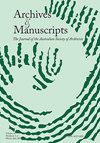Scholarly and professional communication in archives: archival traditions and languages
IF 0.5
Q2 INFORMATION SCIENCE & LIBRARY SCIENCE
引用次数: 1
Abstract
The differences between archival traditions have hindered communication between archival practitioners and scholars from different countries and traditions and have impacted on the success of international recordkeeping projects. Some of the concepts that underpin the current archival literature in English are difficult to translate, one of the reasons being that many other languages do not have a word for the concept of ‘records’. Even within the Anglophone professional community, concepts and terms differ (likewise in the French-, Germanand Spanish-speaking world and other language spheres). Records Continuum concepts, which have influenced the development of the international Records Management standard ISO 15489, are generally misunderstood outside of Australia. On the other hand, very little literature is available in English about archival theories and practices in non-Anglophone countries. More research is needed on the impact of language and culture on recordkeeping traditions and practices. In this special issue of Archives & Manuscripts, we are seeking to develop our knowledge base by bringing together authors that represent different archival traditions and practices. This issue covers important aspects of the archival traditions in France, Italy, Slovenia, Finland, Iceland, Russia, Belarus, Ukraine, Kazakhstan and Japan, and through the discussion of translations of the Universal Declaration on Archives, it brings insights from as far afield as the Dutch Caribbean Islands, the Philippines, China, Iran, Israel and the Arab world. In addition to these, contributions from Germany, Spain, Denmark and Canada were planned for this issue. However, due to increased workloads in the COVID-19 pandemic, the contributors were not able to submit their pieces. From the very first relationships archivists endeavoured across political and cultural borders, coping with differences between archival traditions has been a major challenge. One of the schemes to facilitate communication between archival practitioners and scholars from different countries and traditions was (and still is) the creation of glossaries and dictionaries. These tools, more often than not, are also used to standardise terminologies and practices and thereby contribute to further professionalisation. Such standardisation and professionalisation was the ambition of Dutch archivists Muller, Feith and Fruin who composed the Manual for the arrangement and description of archives (1898). Not only in chapter 6 ‘on the conventional use of certain terms and signs’, but throughout the book the authors strived to standardisation and uniformity in the arrangement and description of archives. Shortly after the publication of the Manual the first translation appeared: a German edition translated by Hans Kaiser, and closely supervised by the Dutch trio. The translation into another language and into another archival tradition led to many, especially terminological questions. Some professional Dutch terms remained untranslated; for others an adequate translation could hardly be found. In his foreword Wilhelm Wiegand ARCHIVES AND MANUSCRIPTS 2021, VOL. 49, NOS. 1–2, 1–7 https://doi.org/10.1080/01576895.2021.1919043档案中的学术与专业交流:档案传统与语言
档案传统的差异阻碍了来自不同国家和传统的档案从业者和学者之间的交流,影响了国际档案保存项目的成功。当前英语档案文献的一些概念很难翻译,原因之一是许多其他语言没有“记录”这个概念的单词。即使在以英语为母语的专业团体中,概念和术语也有所不同(在法语、德语和西班牙语世界以及其他语言领域也是如此)。影响了国际记录管理标准ISO 15489发展的记录连续统概念,在澳大利亚以外通常被误解。另一方面,关于非英语国家档案理论和实践的英文文献很少。语言和文化对记录保存传统和做法的影响需要更多的研究。在这期《档案与手稿》的特刊中,我们试图通过汇集代表不同档案传统和实践的作者来发展我们的知识库。本期杂志涵盖了法国、意大利、斯洛文尼亚、芬兰、冰岛、俄罗斯、白俄罗斯、乌克兰、哈萨克斯坦和日本档案传统的重要方面,并通过对《世界档案宣言》翻译的讨论,带来了远至荷属加勒比群岛、菲律宾、中国、伊朗、以色列和阿拉伯世界的见解。除此之外,德国、西班牙、丹麦和加拿大也计划为本期提供文章。然而,由于COVID-19大流行的工作量增加,撰稿人无法提交他们的作品。从最初的关系开始,档案工作者就努力跨越政治和文化边界,应对档案传统之间的差异一直是一个重大挑战。促进来自不同国家和传统的档案从业者和学者之间交流的方案之一是(现在仍然是)创建词汇和字典。这些工具通常也用于标准化术语和实践,从而有助于进一步专业化。这种标准化和专业化是荷兰档案学家穆勒,菲思和Fruin的野心,他们编写了《档案安排和描述手册》(1898年)。不仅在第6章“关于某些术语和符号的常规使用”中,而且在整本书中,作者都努力在档案的安排和描述中实现标准化和统一性。《手册》出版后不久,第一个译本出现了:汉斯·凯泽(Hans Kaiser)翻译的德文版本,并由荷兰三人组密切监督。翻译成另一种语言和另一种档案传统导致了许多问题,特别是术语问题。一些荷兰专业术语仍未翻译;对另一些人来说,几乎找不到合适的翻译。在他的前言Wilhelm Wiegand ARCHIVES AND manuscript 2021, VOL. 49, no .1 - 2,1 - 7 https://doi.org/10.1080/01576895.2021.1919043
本文章由计算机程序翻译,如有差异,请以英文原文为准。
求助全文
约1分钟内获得全文
求助全文

 求助内容:
求助内容: 应助结果提醒方式:
应助结果提醒方式:


